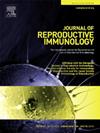The roles of placental senescence, autophagy and senotherapeutics in the development and prevention of pre-eclampsia: A focus on ergothioneine
IF 2.9
3区 医学
Q3 IMMUNOLOGY
引用次数: 0
Abstract
Cellular senescence is a well-established biological phenomenon in eukaryotes. It involves DNA damage, telomere shortening, a senescence-associated secretory phenotype (SASP), and the inability of cells to replicate. It is associated with ageing, and also with oxidative stress. Given the importance of oxidative stress in pre-eclampsia, there is considerable evidence, that we review, that senescence plays an important role in both normal placental development and in the development of both early- and late-term pre-eclampsia. Autophagy is capable of delaying or even reversing the development of senescence, and certain small molecules such as sulforaphane and spermidine can stimulate autophagy, including via the redox-sensitive transcription factor Nrf2. Ergothioneine is a thiohistidine antioxidant that is protective against a variety of cardiovascular and other diseases. Ergothioneine also interacts with Nrf2, and pre-eclampsia occurs far less frequently in individuals with higher plasma ergothioneine levels. Together, these elements provide a self-consistent, molecular and systems biology explanation for at least one mechanism by which ergothioneine may be protective against pre-eclampsia.
胎盘衰老、自噬和衰老治疗在先兆子痫发生和预防中的作用:麦角硫因的研究进展
细胞衰老是真核生物中一种公认的生物学现象。它包括DNA损伤、端粒缩短、衰老相关分泌表型(SASP)和细胞无法复制。它与衰老和氧化应激有关。鉴于氧化应激在子痫前期的重要性,我们回顾了大量的证据,衰老在正常胎盘发育和早期和晚期子痫前期的发展中都起着重要作用。自噬能够延缓甚至逆转衰老的发展,某些小分子如萝卜硫素和亚精胺可以刺激自噬,包括通过氧化还原敏感转录因子Nrf2。麦角硫因是一种硫组氨酸抗氧化剂,可以预防多种心血管疾病和其他疾病。麦角硫因也与Nrf2相互作用,血浆麦角硫因水平较高的个体发生先兆子痫的频率要低得多。总之,这些因素为麦角硫因可能预防先兆子痫的至少一种机制提供了自一致的分子和系统生物学解释。
本文章由计算机程序翻译,如有差异,请以英文原文为准。
求助全文
约1分钟内获得全文
求助全文
来源期刊
CiteScore
6.30
自引率
5.90%
发文量
162
审稿时长
10.6 weeks
期刊介绍:
Affiliated with the European Society of Reproductive Immunology and with the International Society for Immunology of Reproduction
The aim of the Journal of Reproductive Immunology is to provide the critical forum for the dissemination of results from high quality research in all aspects of experimental, animal and clinical reproductive immunobiology.
This encompasses normal and pathological processes of:
* Male and Female Reproductive Tracts
* Gametogenesis and Embryogenesis
* Implantation and Placental Development
* Gestation and Parturition
* Mammary Gland and Lactation.

 求助内容:
求助内容: 应助结果提醒方式:
应助结果提醒方式:


